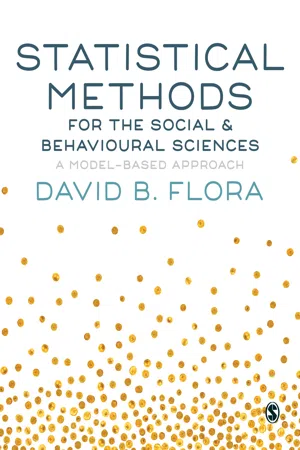
Statistical Methods for the Social and Behavioural Sciences
A Model-Based Approach
- 472 pages
- English
- ePUB (mobile friendly)
- Available on iOS & Android
About This Book
Statistical methods in modern research increasingly entail developing, estimating and testing models for data. Rather than rigid methods of data analysis, the need today is for more flexible methods for modelling data.
In this logical, easy-to-follow and exceptionally clear book, David Flora provides a comprehensive survey of the major statistical procedures currently used. His innovative model-based approach teaches you how to:
- Understand and choose the right statistical model to fit your data
- Match substantive theory and statistical models
- Apply statistical procedures hands-on, with example data analyses
- Develop and use graphs to understand data and fit models to data
- Work with statistical modeling principles using any software package
- Learn by applying, with input and output files for R, SAS, SPSS, and Mplus.
Statistical Methods for the Social and Behavioural Sciences: A Model Based Approach is the essential guide for those looking to extend their understanding of the principles of statistics, and begin using the right statistical modeling method for their own data. It is particularly suited tosecond or advanced courses in statistical methods across the social and behavioural sciences.
Frequently asked questions
Information
1 Foundations of Statistical Modeling Demonstrated with Simple Regression
Chapter overview
- Definition and description of statistical modeling as a guiding theme for the text
- Perspective on effect-size meaning and significance testing used in this book
- Orientation toward the simple linear regression model
- The intercept-only model as a model against which to compare the simple linear regression model
- Foundational principles for simple linear regression
- Specification and estimation of the simple linear regression model
- Statistical inference with the simple linear regression model
- Dichotomous variables in simple linear regression
- Basic concepts for regression diagnostics as they pertain to simple linear regression
- Outliers and unusual cases from the perspective of simple linear regression

What is a statistical model?
A trivial example












Table of contents
- Cover
- Half Title
- Publisher Note
- Title Page
- Copyright Page
- Acknowledgements
- Contents
- Online Resources
- About the Author
- Acknowledgements
- Preface
- 1 Foundations of Statistical Modeling Demonstrated with Simple Regression
- 2 Multiple Regression with Continuous Predictors
- 3 Regression with Categorical Predictors
- 4 Interactions in Multiple Regression: Models for Moderation
- 5 Using Multiple Regression to Model Mediation and Other Indirect Effects
- 6 Introduction to Multilevel Modeling
- 7 Basic Matrix Algebra for Statistical Modeling
- 8 Exploratory Factor Analysis
- 9 Structural Equation Modeling I: Path Analysis
- 10 Structural Equation Modeling II: Latent Variable Models
- 11 Growth Curve Modeling
- References
- Index